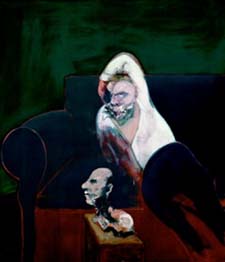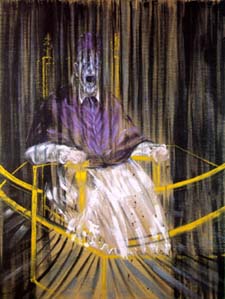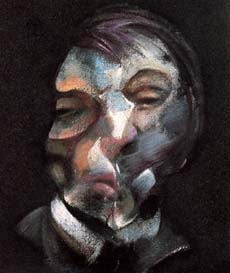|
British painter Francis
Bacon has been dead for ten years, and, in a way,
so has art—at least the kind that makes known the
wounds we inflict on one another and on ourselves. Now
we get that other British bad boy, Damian Hirst, chopping
up animals and distilling them in formaldehyde.
Bacon painted people as
though they were hit with force-ten storms and knifing
rains. Their anxiety chokes them purple. Their edges appear
in fitful blurs. Color is so loud that it comes across
like hostility. Even the pigment looks racked. You feel
assaulted by an unknown dread when you see it. You try
to make sense of it. Bacon said not to try:
"Hardly anyone really feels
about painting. They read things into it—even the
most intelligent people—they think they understand
it, but very, very few people are aesthetically touched
by painting." Culture critic Susan Sontag said something
similar. Too many intellectualize art at the expense of
sensory experience. She called it the "erotics of art."
 |
|
Reclining
Man with Sculpture
|
The "erotics of Bacon's
art" is raw flesh. Ripping past the skin, past surface
reality, he pictured that level of existence within us
that has no visible reality—the panic brought on
by estrangement—not from others, necessarily, but
from ourselves. His paintings are us, inside out.
And Bacon's point in regard
to aesthetics is about the other part of us, our outsides.
Aesthetic form is our physical form—the symmetry
of our limbs and face parts, the contrast of skin to hair
to teeth, which is probably why good composition in art
attracts us. We seek out what we are, what we know.
There're plenty of our
physical selves in Bacon's work. Without it, his expression
of emotion would be just a tantrum made graphic—boneless
and featureless. Like us, Bacon's paintings are aesthetically
structured. While the derangement he illustrates is barefaced,
his configuration of colors and shapes is a physical monument
to order. Call it a mix of truth and beauty. Beyond the
psychic scars that he exposes with color and shape, beyond
his urge to express a state of mind, is the urge to sort
it out and put it right. And that’s where art comes
in: crystallizing/controlling the chaos that is life.
Georges Seurat showed the
same urge in his painting, La Grande Jatte. The
sublime arrangement of tiny dots, made with machinelike
precision, is really Seurat describing the joylessness
of middle-class life. Empty faces and starched, separate
bodies are his icons of alienation in modern life. The
dot matrix magnifies the anonymity of that life.
 |
|
Study
After Velazquez's Portrait of Pope Innocent X
|
Like Seurat, Bacon conveyed
the modern experience of isolation. His Study After
Velasquez: Pope Innocence X is a 17th century figure
passed through the 20th century experience. As if weighed
down by the pressures of orthodoxy, the figure sits on
a throne of gold, looking caged, Bacon's vertical brushwork
approximating prison bars. Yet the architecture of the
picture—the weave of his paint swaths—comes
across like a steady rain, the yellow of the throne looking
like the rays of a sun breaking through.
Bacon's Crouched
Nude shows the same architecture—the caged setting
and the look of a downpour. In much the same way, in his
One of Three Studies for a Crucifixion, the splattered
blood-reds—resembling shafts of light dropped by
a morning sun—seem to paint a new day, the smooth
background reds signaling the unspoiled air.
All of which makes the
crown of gloom over Bacon's work, by contrast, appear
all the more wretched—like a bad traffic accident
on a pretty day.
This is a long way from the
Luis Buñuel film that is said to have influenced
him. By the incoherent, unconnected slices of life in
Un Chien Andalou—such
as dead donkeys lying on two pianos—Buñuel
can be said to have held more sway over Hirst than Bacon.
Consider Hirst's mindless display of an actual pig carcass
cut length-wise, its halves suspended with one inching
back and forth on a mechanized tract so the carcass looks
like it's being constantly sliced.
 |
|
Self-Portrait
|
However disturbing Bacon's
work is, however it pokes out our eyes with edginess,
it’s not the shock art of a Hirst and other artmakers
in the '90s who functioned like a work party of Larry
Flynts, depicting bodily functions and sadomasochistic
acts of gore. Granted, toward the end of his life, Bacon
showed a splatter of blood on the floor of an otherwise
bare room in Blood on the Floor. But by giving
it a context of an empty room, Bacon heightened the sense
of lost life. He made you feel the loss.
Bacon's shock art,
then, never is the stuff of, say, that plastic facsimile
of puke that showed in the '90s at the Whitney in New
York. Or the bed frame there covered by muslin burned
through with hot irons—the burn marks standing for
answers to a sex survey: "More than once a week. Once
a week. Two to three times a month." Bacon also gave us
a bed scene with his Three Studies of Figures on Beds.
But while he shows couples twisted in knots of need, burying
themselves into one another, he gave them context. Bare
walls, lumpy bare mattresses and a naked light bulb heighten
the air of unleashed hunger and abandon, which is far
and away from illustrated answers to a sex survey.
Some say that shock art
has a point, that it's meant to jolt us into realizing
and solving our problems. It doesn't say enough to do
that. It just entertains or enrages us. Bacon's art says
something. He saved his work from the merely shocking
with that mix of truth and beauty in which color reveals
our nervous system and smeary shapes record our cries.
 |
|
Homage
to van Gogh
|
In the autobiography Flaw
in the Glass by Noble Prize winner Patrick White,
Bacon's appreciation of beauty got a mention: "One afternoon
at Battersea, crossing the river together by a temporary
footbridge while the permanent structure was under repair,
he (Bacon) became entranced by the abstract graffiti scribbled
in pencil on its timbered side. Alone, I don't expect
I would have noticed the effortless convolutions of line
he pointed out for me to admire."
Of course, beauty
without truth in art is just as empty as shock art. Impressionism
makes the point, its fleeting brushwork being about surface
things, about our eye, as if that's all we are about:
style. Bacon had us covered. He said, "It's really a question
in my case of being able to set a trap with which one
would be able to catch the fact at its most living point.…
I want to make a thing of sense, of reality, yet unlock
the vowels of feeling."
In Pope Innocent X,
Bacon seems to be saying that each of us is the Pope,
staring from way inside like a scared animal looking out
from a bad hiding place. A passage in Willa Catha's Death
Comes for the Arch Bishop could pass for a description
of the painting: "His mouth was the very assertion of
uncurbed passion...the full lips thrust out and taut,
like the flesh of animals distended by fear or desire."
How important is Bacon?
Think over how much art today reflects on the voltaic
and cybernetic—movies, magazines, television. And
think over how shades of meaning get lost in the electronic
glare. Conditioned by this exposure, too many artists
work like photoelectric sorters, scrambling for new images
as fast as video programs roll over, 20-plexes change
their lineup and newsstands restack. Sealed off from the
rich air of actual life, their images are sterile—like
all things vacuum-packed. Bacon's pictures are a relief
for mass-media-sore eyes. What you see is not what you
get. What you get is beyond seeing: a state of mind—timeless
and placeless.
 |
|
Study
for self-portrait
|
Wait, there's more: Bacon's
originality. Remember that one-of-a-kind thing that art
used to be, when artists told us how they felt about what
they saw, when Mike Bidlo wasn't copying Picassos out
of art books and Richard Pettibone wasn't copying Stella
and Warhol and Elaine Sturtevant wasn't copying Liechtenstein,
Oldenburg and Segal and Sherrie Levine wasn’t copying
Malevich and Schiele and Julian Schnabel wasn’t copying
Rodchenko? Bacon didn't copy anybody. He daydreamed, he
said. "Pictures drop in like slides. The way I see them
is not necessarily related to the way I paint them."
Did you get that? Bacon
doesn't even copy his daydreams. And even while Bacon
shared the need to express inwardness with 20th century's
big gun, abstract expressionism, he never gave up on representing
the seeable. Coming through in his characteristically
frenzied brushwork is everyman crazily furious.
It’s hard to think
of an artist who does that now. Bacon's 10-year absence
is enough to move one to prayer:
Hello, God? Could you send
Francis Bacon back, please? It's getting pretty bad down
here.
|